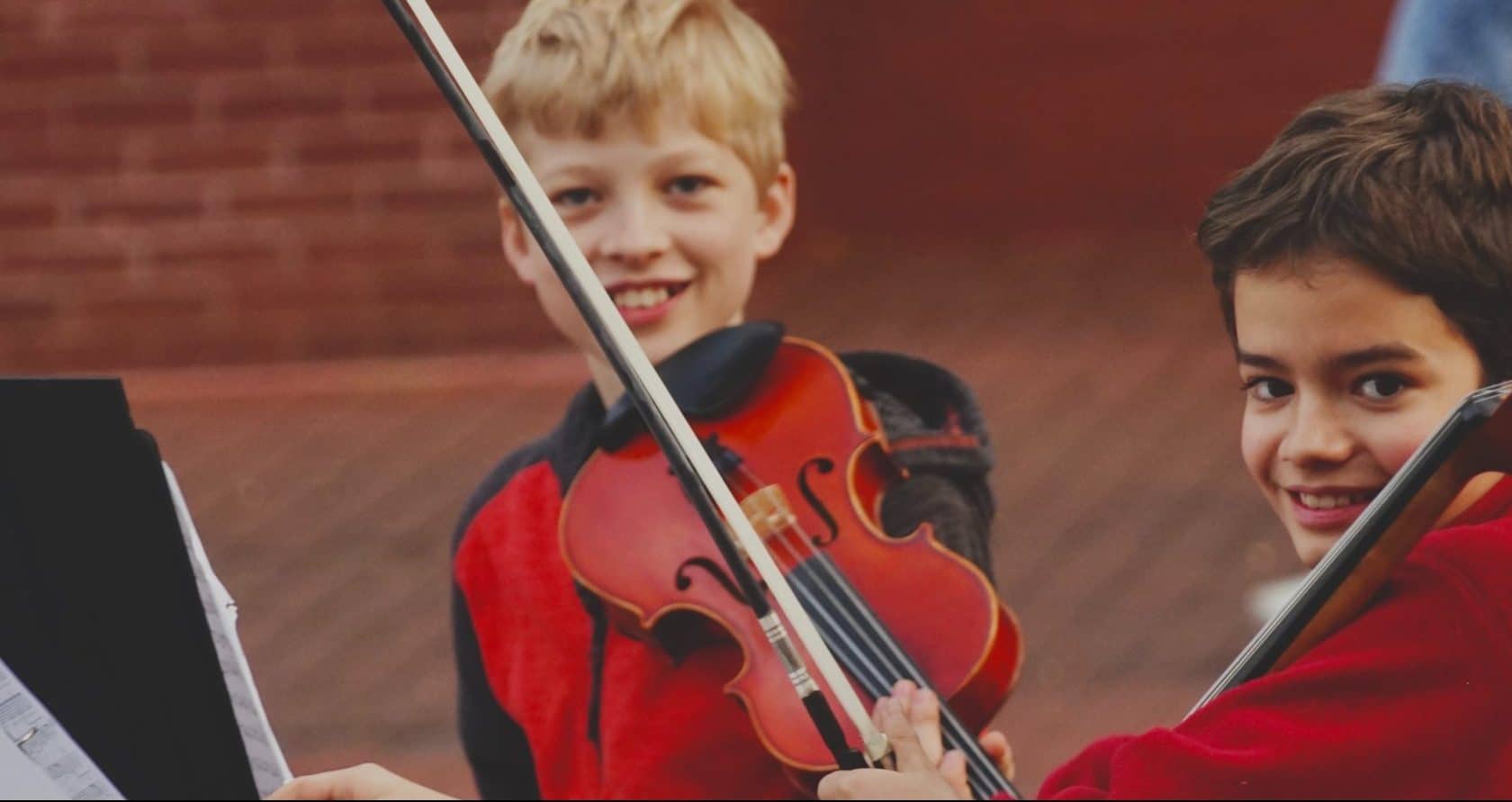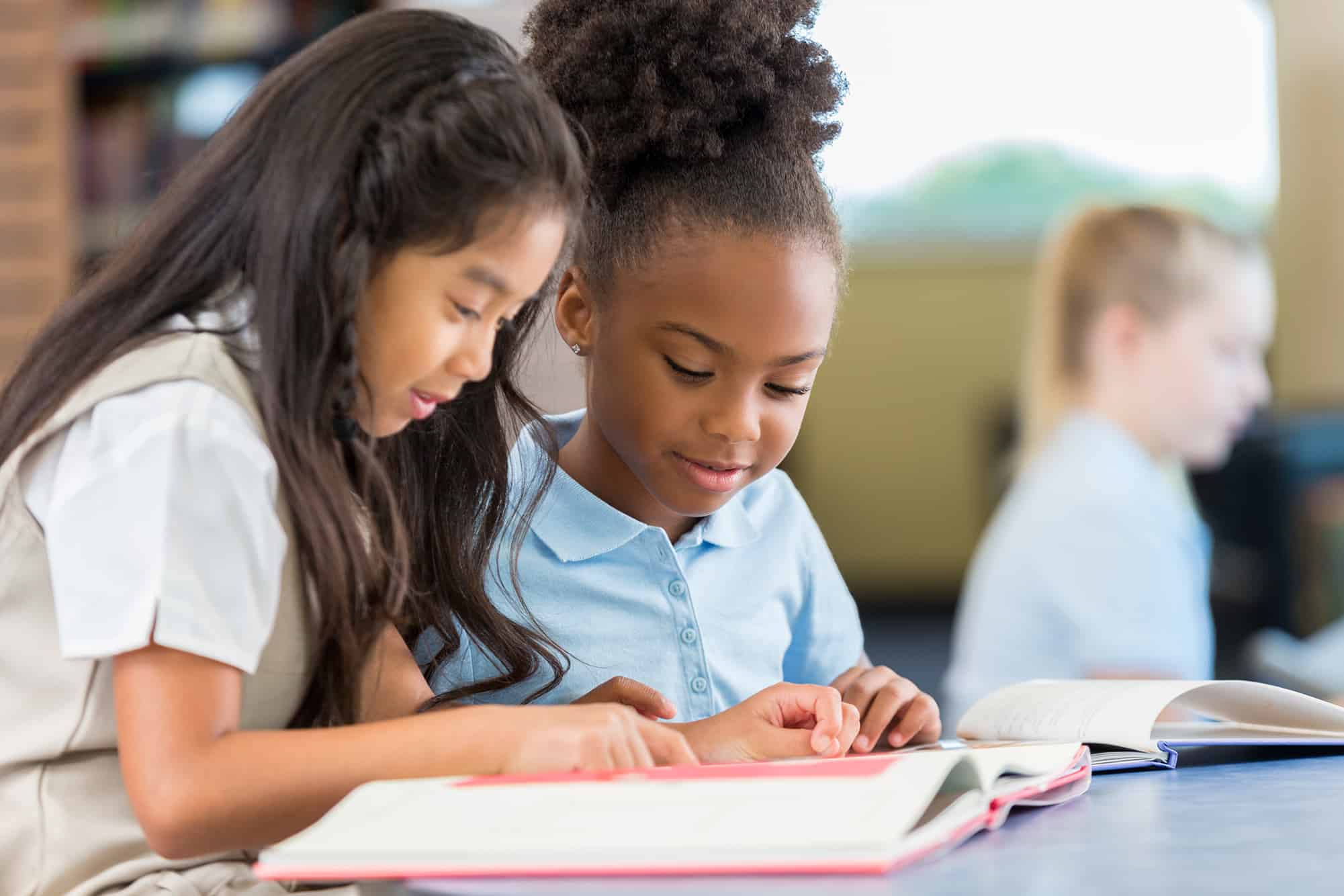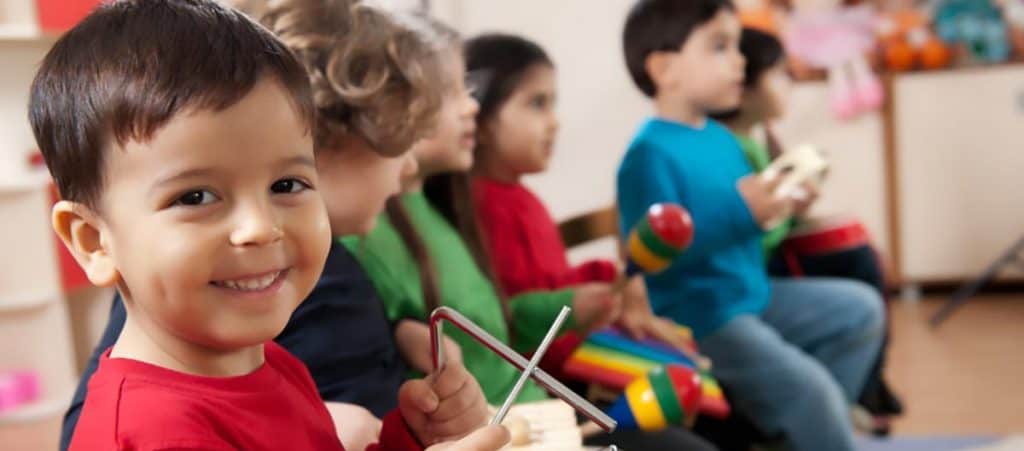Music has the power to calm minds, inspire joy, and help people process tough emotions all at once. But did you know that teaching children about music can boost school performance? Bringing music into your classroom can not only make lessons more engaging, it may also promote cognitive and social-emotional advantages for your students.
Read on to learn more about the emotional and academic benefits of musical education. Then, discover kid-friendly books and activities about music that are perfect for elementary classrooms.
How Music Affects Brain Development and Social-Emotional Learning
 When a child is exposed to musical education from a young age, the parts of their brain that process sound, speech, reading, and language develop at an accelerated rate.[1] These cognitive benefits of music transfer directly to academic success. One study found that children who participated in musical activities had higher overall academic grades than those who did not.[2]
When a child is exposed to musical education from a young age, the parts of their brain that process sound, speech, reading, and language develop at an accelerated rate.[1] These cognitive benefits of music transfer directly to academic success. One study found that children who participated in musical activities had higher overall academic grades than those who did not.[2]
In addition, music education is linked to social-emotional development. For example, children who participate in extracurricular music programs typically develop stronger social skills—particularly communication with their parents, teachers, and classmates.[3]
Music education also has the potential to raise self-esteem. A study at Northwestern Oklahoma State University found that children involved in their school’s music program felt better about their individual growth and had fewer feelings of alienation.[4]
40 Music Activities for the Kids in Your Classroom
1. Use the New York Philharmonic KidZone to play musical games and learn a little about orchestras.
2. Print out a music-themed I Spy activity and see how many of the items your students can spot.
3. Play a singing game for a musical activity that requires no instruments.
4. If you have a copy of the picture book at your school library, try this Chicka Chicka Boom Boom-themed rhythm game.
5. This brain break uses a popular children’s song to help students practice literacy and music skills.
6. PBS Kids offers plenty of music games featuring characters your students may already know.
7. To teach your students about different notes, try dot composing.
8. Learning music history can be fun with Classics for Kids as a guide.
9. If your classroom is learning remotely, try Music at Home Bingo.
10. If you have a piano or keyboard on hand, this Grizzly Bear music game can be a lot of fun.
11. The solfeg.io website teaches children musical notation using classic or pop songs.
12. As long as you have dice on hand, this Shake and Tap activity is both fun and easy to set up.
13. For a musical social-emotional learning activity, try listening to classical music that can help children learn about emotions.
14. Put together DIY pan flutes and see what kind of melodies your students can come up with together.
15. To teach students about different musical notes, print out and play with these matching cards.
16. This Music Monsters activity is great for teaching older elementary students a quick lesson on composition.
17. Try one of these clap-along videos to practice rhythm with your students.
18. Make these Baa Baa Black Sheep puppets together, then sing the popular nursery rhyme.
19. For a kid-friendly activity of a more advanced concept, play the Monkey Game, which teaches children about crescendos and decrescendos.
20. This interactive music game is great for classrooms that are still distance learning.
21. Play musical charades (#2 on this list) to get your students moving and bonding as a class.
22. The Utah Symphony offers music scavenger hunts that students can complete while watching a performance on YouTube.
23. Sing “Charlie Over the Ocean”, a popular call-and-echo song that’s great for classrooms.
24. Play MusicMan (#1 on this list), an artsy and fun twist on hangman.
25. This My Book of Instruments print-out can be enjoyable for students to color in while learning about different instruments.
26. These music games all get children moving by mixing music with sports.
27. For an activity your students will love to take home, make rubber band harmonicas.
28. This Musical Jars activity doubles as a great STEM experiment.
29. This name game can help your students learn a little more about treble clefs.
30. The Isle of Tune website is great for teaching children about musical composition in a visual way.
31. Print out these rhythm cards and use them to practice clapping along to a song.
32. This Song Cubes activity can be a fun way for early elementary students to learn about simple tunes and rhythms.
33. For an activity you can keep going throughout the year, visit the Composer of the Month website as a class.
34. Explore Carnegie Hall Listening Adventures for plenty of kid-friendly activities from the renowned music venue.
35. For a STEAM (science, technology, engineering, art, and math) activity, try one of these Science of Sound experiments.
36. If you’re looking for a sensory activity that younger students will enjoy, make rainstick bottles.
37. This rhythm game is great for teaching students about percussion.
38. If your classroom has tablets available, try TuneTrain—a free app that teaches children how to create music.
39. These singing activities are all Zoom-compatible for distance learning classrooms.
40. Do the robot dance for an exciting way to practice gross motor skills.
10 Picture Books About Music
1. Movin’ to the Music Time by Cherry Lyon Jones and Wayne Andreason
When one little girl hears music, she can’t help but dance. This book is a free digital copy offered by Waterford—meaning you can print or share it online with your class.
2. Ketzel, the Cat who Composed by Lesléa Newman and Amy June Bates
Did you know that Jewish composer Moshe Cotel had a cat who helped him write an award-winning song? This picture book is extra special because it’s based on a true story.
3. Duke Ellington: The Piano Prince and His Orchestra by Andrea Davis Pinkney and Brian Pinkney
Duke Ellington is known as one of the best jazz musicians of all time. Learn about his life and art in this Corretta Scott King Award-winning book.

4. Do Re Mi: If You Can Read Music, Thank Guido D’Arezzo by Susan Roth
The invention of musical notes revolutionized the art form and made it so that songs can last forever. Learn all about Guido D’Arezzo, the man who invented written music.
5. Becoming Bach by Tom Leonard
Johann Sebastian Bach grew up surrounded by music. Learn how this composer used his knack for patterns and melodies to create his renowned art.
6. Zin! Zin! Zin! A Violin by Lloyd Moss and Marjorie Priceman
Looking for a playful and vibrant way to teach children about instruments and musical notes? This picture book uses colorful illustrations and light humor to offer a quick music lesson.
7. Elvis Is King! by Jonah Winter
Elvis Presley is the indisputable king of rock ‘n’ roll, and people of all ages still love his songs. Learn what made his music so revolutionary and how he battled stage fright as a child in this picture book.
8. We Shall Overcome: The Story of a Song by Debbie Levy and Vanessa Brantley-Newton
This picture book shares the history of “We Shall Overcome,” a song known as the anthem of the civil rights movement. Discover how this song has inspired generations to fight for freedom and against injustice.
9. I Know a Shy Fellow Who Swallowed a Cello by Barbara S. Garriel and John O’Brien
Need a picture book that you can sing along with? The rhymes in this story follow the tune of “There Was an Old Lady Who Swallowed a Fly.”
10. Red Bird Sings: The Story of Zitkala-Ša, Native American Author, Musician, and Activist by Gina Capaldi and Q.L. Pearce
Zitkala-Ša was a Native American activist known for her musical talent. Learn about her life and mission to fight for civil rights, along with her artistic achievements.
Sources:
- Gersema, E. Children’s brains develop faster with music training. University of Southern California News. https://news.usc.edu/102681/childrens-brains-develop-faster-with-music-training/.
- Wetter, O. E., Koerner, F., and Schwaninger, A. Does musical training improve school performance? Instructional Science: An International Journal of the Learning Sciences, July 2009, 37(4), pp. 365-374.
- Broh, B. A. Linking extracurricular programming to academic achievement: Who benefits and why? Sociology of Education, 2002, 75(1), pp. 69-95.
- Jenlink. C.L. The Relational Aspects of a School, a Music Program, and At-Risk Student Self-Esteem: A Qualitative Study. Northwestern Oklahoma State University. https://shareok.org/bitstream/handle/11244/316911/Thesis-1993D-J53r.pdf?sequence=1&isAllowed=y.

